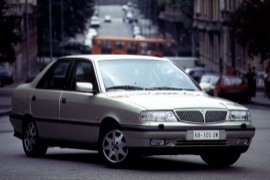
LANCIA Dedra
Generations Timeline, Specs and Pictures

Lancia refreshed the Dedra twice between 1989 and 2000 when it ended the production, and the second facelift introduced in 1995 cut its power and made it more affordable.
Based on the same platform with the Fiat Tempra and Delta’s second generation, the Dedra was built by Lancia as a successor for the Prisma, but the results were less than satisfactory. It managed to sell the car in just 414,084 units in both versions: sedan and station wagon. That meant less than 40,000 units per year.
Strangely, the Italians were caught on the wrong foot with Dedra’s design. While the rest of the carmakers started to get into the bio-design trend, the Dedra featured a late-’80s look with sharp lines, angular headlights, and taillights. With the ‘95 refresh, the carmaker tried to soften the lines, but it was not enough.
The interior sported the same materials. They were good, with nice velour upholstery and the same dashboard like the one fitted on the first facelifted version. It featured a nicely curved top section over the instrument panel and the center stack. It kept the most important advantage of the car, the very wide door aperture, which made the ingress and egress easier.
But under the hood, Lancia focused on customers’ choices, not on their engineers’ dreams. While the Dedra was available with a turbocharged all-wheel-drive system, the buyers turned their eyes to the 1.6-liter naturally aspirated gasoline units and the 90 hp turbo-diesel engine. Lancia kept the “Integrale” (all-wheel-drive) version, but only for the naturally aspirated, 136 hp 2.0-liter 16-valves unit.

The Lancia Dedras was a medium-class vehicle produced by the Italian manufacturer Lancia between 1989 and 1999.
The model built in Chivasso was unveiled in 1898 and was meant to replace the older Lancia Prisma that had became too dated to compete with the rivals on the market.
For economy-related reasons, the Dedra was built on the same platform as the Fiat Tipo, and also shared with the Fiat Tempra revealed in the same year, 1990.
The Dedra featured many of the characteristics of the Tipo, as well as the Tempra’s. The sedan was equipped with a considerable luggage compartment capacity, similar to the Tempra’s.
With the design created by I.DE.A Institute, the Lancia Dedra achieved an excellent drag coefficient of only 0,29.
The Dedra looked more like a car the was able to satisfy the users looking for an elegant sedan, but couldn’t afford one in the higher segment.
The passenger compartment was easily accessible thanks to the wide opening angles of the doors. However, the space inside was more adequate for 4 adults, as 5 adults would have not enjoyed longer trips due to the limited room.
To enhance comfort, optional leather or Alcantara upholstery was available.
The driving position was well designed thanks to the highly adjustable seats, as well as a heigh-adjustable four-spoke steering wheel.























































